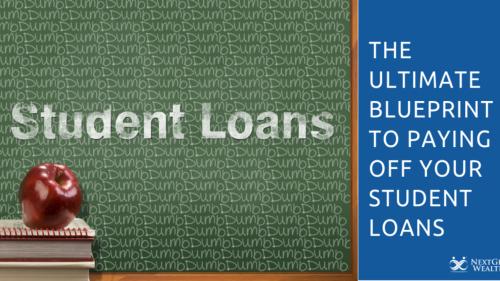The Ultimate Blueprint To Paying Off Your Student Loans
With student loan debt, it can seem like your payments will last forever. But, there are ways to make paying off your student loans much easier. Whether you’re in the thick of paying them off, considering taking out student loans, or somewhere in the middle, knowing the right strategies to use will save you a lot of money and stress when it comes to paying off your student loans faster.
As the second highest consumer debt, the average student loan balance tops $37,000 for the Class of 2016. If most of your paycheck goes to pay student loans because you haven’t yet met your earning potential, you can feel trapped. There is hope, and you can get rid of your debt faster by upgrading your student loan repayment options.
Paying Off Your Student Loans Faster
Once you understand your student loans and the basics of repayment, you can quickly implement the following options to pay off your student loans:
- Start living on a monthly budget
- Pay the interest while you're still in school
- Make more than the minimum required payment
- Consolidate or refinance for lower interest and shorter repayment periods
- Avoid income-driven repayment plans
- Think about living with your parents or a roommate to free up more cash
- Pay a lump-sum when you come into extra money
- Use a raise at work to increase your student loan payment amount (instead of your lifestyle)
- Start a side-gig or get a second job to pay off your student loans
- Reduce monthly expenses by living a frugal lifestyle
- Make student loan payments automatic
- Imagine your life without student loan debt
The Basics of Student Loans
When applying for financial aid, most schools include student loans as part of your enrollment package. There are two types of loans to consider when looking for help to finance your education: federal student loans and private student loans.
Federal student loans are funded by the federal government, and include federal parent loans, too. Private loans are generally more expensive than federal ones, and you get them from a private lender such as a bank, credit union, or a school rather than through a federal loan servicer.
When applying for a student loan, the first step is to fill out the Free Application for Federal Student Aid (FAFSA) and deliver it to your school's financial aid department. There is no cost to fill out the FAFSA, and it gives you access to the largest funding source to pay for college or career school. It also is used to determine your eligibility for state and school aid, making it an important part of the college process.
The Basics of Repayment
Once you graduate, or if you leave school or drop below half-time enrollment, you’ll have several student loan repayment options. Most, including federal loans, have a six-month grace period before your first student loan payment is due.
During this grace period, you have a chance to find a job and begin earning income. You can also use this time to prepare for your student loan payments by:
- Communicating with your loan servicer
- Researching student loan repayment options
- Creating a budget built around your student loan payments
- Learning how to prioritize paying off your student loans
- Setting up automatic payments to avoid late fees
Start Living on a Monthly Budget
Living on a budget doesn’t always mean penny-pinching, using coupons, and saying no to fun activities. It’s designed to help you take control of your finances and shape your financial future and, when done right, a budget can help you with paying off your student loans faster.
To start, write down your net income and subtract your fixed costs, like housing, utilities, transportation, and student loan payments. Knowing how much you have left after you pay your necessary bills will help you decide how much to spend on flexible expenses, like dining out, clothes, or entertainment.
After your budget is set up, get creative about using the money you have left after your fixed expenses are paid. The more you cut spending by limiting how often you go out to eat or buy a coffee on your way to the office, the more money you’ll have to put towards paying off your student loans.
Pay the Interest While You're Still in School
If you want to get a head start on paying off your student loan debt, you could save thousands by making interest-only payments while you’re still in school. In most cases, compound interest works against you by adding interest to the interest your loan accrues month after month.
But paying the interest while you’re still in school will reduce the effects of compound interest, making it work for you instead. Paying only the interest will significantly reduce your loan balance while you’re still in school, putting you in a better position to pay them off faster once you graduate.
To find out how much interest your loan is accruing each month, log into your student loan servicer account to see your loan details. From there, you’ll find out how much interest is added to your loan each month.
As an example, the interest payment for a $10,000 loan with 7% interest is only $57 a month. Making even this small payment will help to chip away your balance and make paying off your student loans a faster process.
Make More than the Minimum Required Payment
Once you graduate, your repayment term will last between 10 to 20 years, though some repayment plans will extend to 25 years or more. If the idea of paying off your education for a decade or two after you leave college is overwhelming, one of the best student loan repayment options to speed up the process is to make more than the minimum payment.
Your monthly student loan payment is calculated based on the total amount borrowed, the repayment period, and your interest rate. This monthly payment is the minimum required payment, and anything you pay in addition to that will pay off the principal of the loan much more quickly. It will also significantly reduce the amount of money you spend over the life of the loan by reducing the amount of interest you pay overall.
When making more than the minimum payment, remember that every little bit helps. Even an extra $20 or $50 a month will go a long way to help pay off your student loans faster.
Consolidate or Refinance for Lower Interest and Shorter Repayment Periods
During your college years, it’s likely you took out a different loan each year to cover the costs of your education. When you graduate, instead of paying on each loan individually, you can simplify your payments by consolidating or refinancing your debt into one loan.
For federal student loans, a Direct Consolidation Loan will allow you to combine multiple debt accounts into one single monthly payment. Another student loan repayment option is refinancing through a private lender. Most banks will review your credit score, annual income, and type of college degree to determine if you’re an excellent candidate for student loan refinancing.
Much like a Direct Consolidation Loan, refinancing through a private lender will combine all of your loans into one monthly payment. Watch out for interest rates and the length of the repayment period to make sure it lines up with your goals to pay off your student loan faster.
Also, beware that once you consolidate to a private lender that you will be giving up the loan forgiveness options. That’s why it’s absolutely crucial you speak with a professional before signing any paperwork.
Avoid Income-Driven Repayment Plans
Money is tight when you’re first starting out after college and lowering your student loan payments is a tempting option. This makes a lot of sense if you’re struggling to repay them, but the federal income-driven repayment (IDR) plans are geared toward decreasing payments by lengthening the life of the loan. When you’re working towards paying off your student loans faster, using an IDR plan will not work in your favor.
For instance, the Pay As You Earn (PAYE) IDR plan extends your repayment term from 10 years to 20 years. Having a longer loan period will lower your monthly payment, but you’ll accrue huge amounts of interest since you’re now paying on your student loan for two decades instead of one.
With the added interest over 20 years, you’ll end up paying way more than you otherwise would have. It’s best to avoid IDR plans altogether if your goal is to pay off student loans as fast as you can.
Think About Living with Your Parents or a Roommate to Free Up More Cash
After college, you’re finally free to start your life as an adult. The trouble is that being an adult doesn’t come cheap – rent, utilities, groceries, and insurance consume a large part of your paycheck each month. When you add it all up, the cost of living on your own can make paying back your student loans more challenging.
Moving back home to live with your parents is one student loan repayment option to consider. Though living under your parents’ rules again after the freedom you had in college could prove difficult, it’s an excellent move to save money and pay off your student loans faster.
If moving in with your parents isn’t an option, getting a roommate to share housing and utility costs is a great choice to free up more of your money to pay down student loan debt. You probably lived with a roommate while in college, so this shouldn’t be a hard adjustment to make. And the faster you pay off your student loans, the sooner you’ll have money available to buy a car or a house, or to invest and begin to build wealth.
Pay a Lump-Sum When You Come into Extra Money
Sometimes life brings with it the opportunity to get a large lump-sum of money all at once. This might happen in the form of a tax refund, a bonus at work, inheritance, or insurance settlement, and can pointedly reduce your student loan expenses.
For example, making a $5,000 lump-sum payment on a $30,000 student loan could cut almost two years off your repayment period and get you out from under your student loan debt that much faster.
When you make student loan payments all year, you’re usually able to write off some of the interest you’ve paid at tax time. Putting a large lump-sum on your loan won’t affect your ability to claim this tax deduction since the deduction applies whether you paid in equal monthly installments or included one or more large payments.
Before you make a lump-sum payment, make sure you have money in savings as a backup plan in case of an emergency. If you’re not careful, draining your savings account to get rid of student loans can backfire. Should your car break down or you lose your job, you’ll need to have money set aside until you get back on track.
Use a Raise at Work to Increase Student Loan Payment Amount (Instead of Your Lifestyle)
With your college degree in-hand, chances are you landed a job where annual raises are part of the overall compensation plan. While you’re expecting to make a little more each year at work, it’s easy to make plans to spend that extra income to inflate your lifestyle. Instead, plan ahead to put that extra money toward your debt.
Sure, a bigger TV, newer car, or luxury vacation all sound great but instead of buying more stuff, putting your raise toward paying off your student loan will get rid of your debt even faster. If you’re struggling financially, you can still make a significant impact on your student loans if you take half of your raise and put it toward your payments.
Start a Side-Gig or Get a Second Job to Pay Off Your Student Loans
If your career position out of college doesn’t pay quite enough to make headway with your student loans, the best option is to find a higher paying job. For new graduates, it can take time to develop your leadership skills and cross-train to expand your skill set to qualify for a position with better pay. In the meantime, you can earn money in your spare time by starting a side-gig or getting a second job.
Fiverr is an online platform where you can offer to do a task for $5. Some options are online marketing, writing and translation, writing LinkedIn profiles, converting PDF files to word, and tons more. For a more laid-back approach, Swagbucks is a legitimate site that pays you to complete surveys, and that is an easy way to earn extra money each month to pay off your student loans.
For those who love driving, Uber or Lyft drivers make up to $35 an hour. If you don’t mind picking up strangers and taking them to their destination, this could make you a lot of extra money to use for paying down your student loans.
Animal lovers can start pet sitting or walking dogs to earn extra money on the side. Hanging up a flyer at your local supermarket is an easy way to get started in the pet-care business, or check out Petsitter.com and Care.com for gigs.
With expert knowledge of a skill or subject, being a tutor or giving lessons is a great student loan repayment option. It’s likely you already have connections in your personal and professional network to start offering test-prep help with the ACT, SAT, or other exams, or to start offering music or sports and fitness lessons.
The critical factor to remember when running a side-gig or second job is to use the income you earn for paying your student loans. It won’t help you get out from under your debt any faster if you use the extra money to buy more fast-food or concert tickets.
Reduce Monthly Expenses by Living a Frugal Lifestyle
Living a frugal lifestyle is easier than you might think. Instead of spending your time clipping coupons or skipping your morning latte, making big changes will have a significant impact on your goal to pay off your student loans.
One of the largest expenses you can cut is buying soda. The average American spends $850 a year on soft drinks and, when you break it down, that’s an additional $70 a month you could use to pay off your student loan faster.
It’s likely you also overspend when it comes to groceries, too. Take a few minutes to plan your meals for the upcoming week and base your grocery shopping around where you need to trim your expenses and free up extra cash to pay down your debt.
Maybe you can get rid of your gym membership and save money on clothes by shopping thrift stores or taking advantage of sales, and put the money toward student loan debt instead. Another option to reduce your monthly expenses is to shop around for lower car insurance premiums every few years to make sure you’re getting the best rate.
Make Student Loan Payments Automatic
Any time you pay a bill after the due date, you’re charged a late fee. Not only is it a waste of money, but it can affect your credit score and damage your overall credit. With so many factors, like insurance rates and employment opportunities dependent on a decent credit score, you can’t afford a late fee.
Making student loan payments automatic is the best way to avoid defaulting on your loan and paying out late fees. The easiest option to set up electronic payments is to log into your loan servicer and set up their auto-pay program to draft the amount from your bank account each month.
You can also set up automatic payments from your bank account through online bill pay. Once you log into your bank’s website, it’s as simple as entering your lender as a payee and setting up a monthly, automatic payment to them. A word of warning if you’re going to use your bank’s bill pay: payments typically take a few days to process and, to avoid late fees, set your transaction to occur a few days before your due date.
Imagine Your Life without Student Loan Debt
Think about how you’ll feel once you’re free from the weight of student loan debt. Not only will your stress level go down, but your financial future will look brighter, and new opportunities for building wealth will open up to you, too.
Even though you may have taken out student loans before you knew the long-term impact they’d have on your financial health, there are ways to alleviate the burden of debt and live a better life. When it comes to managing your student loan debt, there is a lot you can control to get it done faster.
This is a post from Clint Haynes, a Certified Financial Planner® and Financial Advisor in Kansas City, Missouri. He is also the founder and owner of NextGen Wealth. You can learn more about Clint at the website NextGen Wealth.



